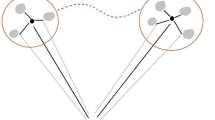Abstract
When the elevation of targets is smaller than beamwidth, the coherent multi-path signals will significantly degrade the direction of arrival (DOA) estimation accuracy of existing methods for a very-high-frequency (VHF) radar system. Through detailed theoretical analysis, we demonstrate that the phase distortion is the key factor of degrading the accuracy of DOA estimation. Hence, a novel phase enhancement model based on supervised convolutional neural network (CNN) for coherent DOA estimation is proposed to mitigate the phase distortion and improve estimation accuracy. The results of simulation experiments and real data have demonstrated the superiority of proposed method in DOA estimation accuracy and resolution compared to classic physics-driven methods. Moreover, the proposed scheme is suitable for the coherent DOA estimation compared with existing data-driven methods.

















Similar content being viewed by others
References
Xu Z, Xiong Z, Wu J, Xiao S (2016) Symmetrical difference pattern monopulse for low-angle tracking with array radar. IEEE Trans Aerosp Electron Syst 52(6):2676–2684. https://doi.org/10.1109/TAES.2016.140436
Sebt MA, Sheikhi A, Nayebi MM (2010) Robust low-angle estimation by an array radar. IET Radar, Sonar Navigation 4(6):780–790. https://doi.org/10.1049/iet-rsn.2009.0067
Chen B, Zhao G, Zhang S (2010) Altitude measurement based on beam split and frequency diversity in VHF radar. IEEE Trans Aerosp Electron Syst 46(1):3–13. https://doi.org/10.1109/TAES.2010.5417144
Zhu W, Chen B (2013) Altitude measurement based on terrain matching in VHF array radar. Circuits Systems and Signal Processing 32(2):647–662
Schmidt R (1986) Multiple emitter location and signal parameter estimation. IEEE Trans Antennas Propag 34(3):276–280. https://doi.org/10.1109/TAP.1986.1143830
Haykin S, Greenlay T, Litva J (1985) Performance evaluation of the modified fblp method for angle of arrival estimation using real radar multipath data. IEE Proceedings F - Communications, Radar and Signal Processing 132(3):159–174. https://doi.org/10.1049/ipf-1.1985.0038
Shan TJ, Wax M, Kailath T (1985) On spatial smoothing for direction-of-arrival estimation of coherent signals. IEEE Trans Acoust Speech Signal Process 33(4):806–811. https://doi.org/10.1109/TASSP.1985.1164649
Pettersson L, Grahn P (2003) Experiences using doa methods with a small digital beamforming antenna. In: IEEE International Symposium on Phased Array Systems and Technology 2003:164–169. https://doi.org/10.1109/PAST.2003.1256975
Ziskind I, Wax M (1988) Maximum likelihood localization of multiple sources by alternating projection. IEEE Trans Acoust Speech Signal Process 36(10):1553–1560. https://doi.org/10.1109/29.7543
Liu Y, Zhou B, Han C, Guo T, Qin J (2020) A novel method based on deep learning for aligned fingerprints matching. Appl Intell 50:397–416. https://doi.org/10.1007/s10489-019-01530-4
Kuang P, Ma T, Chen Z, Li F (2019) Image super-resolution with densely connected convolutional networks. Appl Intell 49:125–136. https://doi.org/10.1007/s10489-018-1234-y
Noda K, Yamaguchi Y, Nakadai K et al (2015) Audio-visual speech recognition using deep learning. Appl Intell 42:722–737. https://doi.org/10.1007/s10489-014-0629-7
Brkljač B, Janev M, Obradović R et al (2014) Sparse representation of precision matrices used in GMMs. Appl Intell 41:956–973. https://doi.org/10.1007/s10489-014-0581-6
Zooghby AHE, Christodoulou CG, Georgiopoulos M (2000) A neural network-based smart antenna for multiple source tracking. IEEE Trans Antennas Propag 48(5):768–776. https://doi.org/10.1109/8.855496
Zooghby AHE, Christodoulou CG, Georgiopoulos M (1997) Performance of radial-basis function networks for direction of arrival estimation with antenna arrays. IEEE Trans Antennas Propag 45(11):1611–1617. https://doi.org/10.1109/8.650072
Shieh CS, Lin CT (2000) Direction of arrival estimation based on phase differences using neural fuzzy network. IEEE Trans Antennas Propag 48(7):1115–1124. https://doi.org/10.1109/8.876331
Xu Z, Rao B, Xiong Z, Zhang L, Xiao S (2013) Elevation finding algorithm in beam domain under multi-path environments for VHF radar. IET Radar, Sonar Navigation 7(9):978–984. https://doi.org/10.1049/iet-rsn.2012.0221
Xiang H, Chen B, Yang M, Yang T, Liu D (2019) A novel phase enhancement method for low-angle estimation based on supervised DNN learning. IEEE Access 7:82329–82336. https://doi.org/10.1109/ACCESS.2019.2924156
Zheng Y, Chen B, Yang M (2016) Cramer-rao bound of the estimation of direction of arrival for low angle targets. In: 2016 CIE International Conference on Radar (RADAR), pp. 1–4. DOI:https://doi.org/10.1109/RADAR.2016.8059311
Lecun Y, Bottou L, Bengio Y, Haffner P (1998) Gradient-based learning applied to document recognition. Proc IEEE 86(11):2278–2324. https://doi.org/10.1109/5.726791
Alizadehashraf, B., Roohi, S. (2017) Persian handwritten character recognition using convolutional neural network. In: 2017 10th Iranian Conference on Machine Vision and Image Processing (MVIP), pp. 247–251. DOI:https://doi.org/10.1109/IranianMVIP.2017.8342359
Wu C, Fan W, He Y, Sun J, Naoi S (2012) Cascaded heterogeneous convolutional neural networks for handwritten digit recognition. In: Proceedings of the 21st International Conference on Pattern Recognition (ICPR2012), pp. 657–660
Ahranjany SS, Razzazi F, Ghassemian MH (2010) A very high accuracy handwritten character recognition system for Farsi/Arabic digits using convolutional neural networks. In: 2010 IEEE Fifth International Conference on Bio-Inspired Computing: Theories and Applications (BIC-TA), pp. 1585–1592. DOI:https://doi.org/10.1109/BICTA.2010.5645265
Ranzato M, Huang FJ, Boureau Y, LeCun Y (2007) Unsupervised learning of invariant feature hierarchies with applications to object recognition. In: 2007 IEEE Conference on Computer Vision and Pattern Recognition, pp. 1–8. DOI:https://doi.org/10.1109/CVPR.2007.383157
Glorot X, Bordes A, Bengio Y (2011) Deep sparse rectifier neural networks. In: International Conference on Artificial Intelligence and Statistics, pp. 315–323
Srivastava N, Hinton G, Krizhevsky A, Sutskever I, Salakhutdinov R (2014) Dropout: a simple way to prevent neural networks from overfitting. J Mach Learn Res 15(1):1929–1958
Werbos PJ (1990) Backpropagation through time: what it does and how to do it. Proc IEEE 78(10):1550–1560. https://doi.org/10.1109/5.58337
H.-N. R. (1989) Theory of the backpropagation neural network, vol. 1. Harcourt Brace & Co.
LeCun Y, Boser B, Denker JS, Henderson D, Howard RE, Hubbard W, Jackel LD (1989) Backpropagation applied to handwritten zip code recognition. Neural Comput 1(4):541–551. https://doi.org/10.1162/neco.1989.1.4.541
Kingma DP, Ba J (2014) Adam: A method for stochastic optimization. Computer Science
Acknowledgements
This work was supported by the National Natural Science Foundation of China (No. 61571344, No. 61971323), Fundamental Research Funds for the Central Universities and the Innovation Fund of Xidian University. The authors sincerely express their gratitude to anonymous reviewers and editors for their helpful and constructive comments and suggestions.
Author information
Authors and Affiliations
Corresponding author
Ethics declarations
Conflict of interest
The authors declared that they have no conflicts of interest.
Additional information
Publisher’s note
Springer Nature remains neutral with regard to jurisdictional claims in published maps and institutional affiliations.
Rights and permissions
About this article
Cite this article
Xiang, H., Chen, B., Yang, T. et al. Phase enhancement model based on supervised convolutional neural network for coherent DOA estimation. Appl Intell 50, 2411–2422 (2020). https://doi.org/10.1007/s10489-020-01678-4
Published:
Issue Date:
DOI: https://doi.org/10.1007/s10489-020-01678-4




